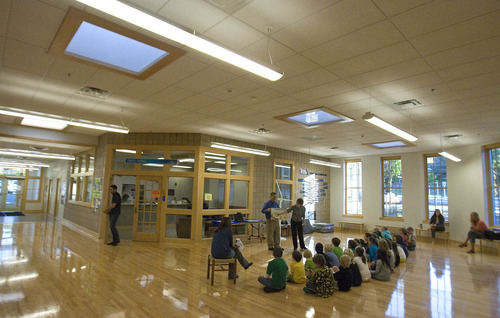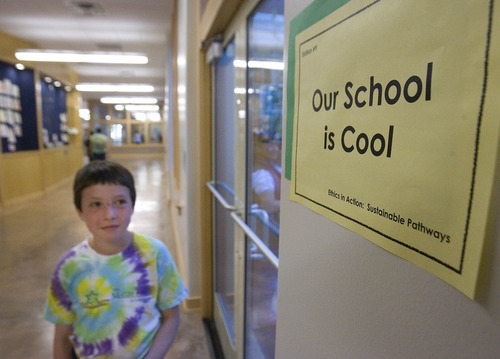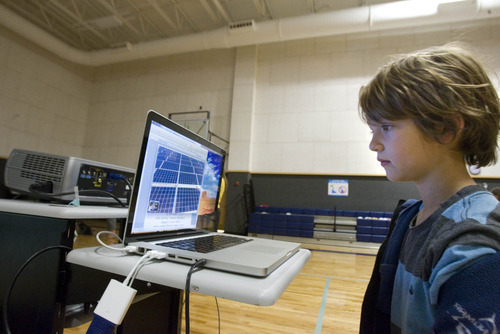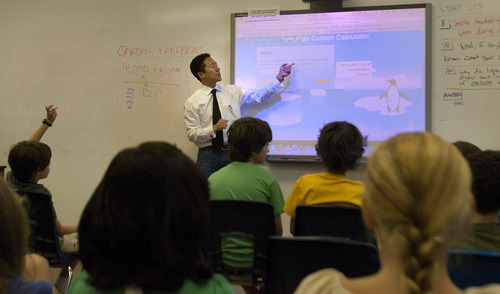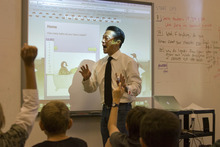This is an archived article that was published on sltrib.com in 2011, and information in the article may be outdated. It is provided only for personal research purposes and may not be reprinted.
In the gym, students sat on a floor made of wood from sustainable forests, learning about the school's 117 new rooftop solar panels.
Near the school's entrance, they learned about energy under a ceiling spotted with skylights designed to reduce the need for artificial lighting.
And in the school's new Zen Garden, a small outdoor courtyard dotted with low-water use plants, they learned about volatile organic compounds.
Students at The McGillis School in Salt Lake City, 668 S. 1300 East, spent Oct. 14 learning about the environment in honor of its newest designation as the first elementary, middle or highschool in Utah to become Gold LEED certified, according the U.S. Green Building Council. Buildings must meet certain environmental standards in order to become LEED (Leadership in Energy and Environmental Design) certified, and gold is the second highest level of certification possible, achieved by about 86 other schools nationwide, according to the council.
McGillis achieved the certification for its new 57,000-square-foot addition, finished last year at a cost of nearly $10 million, said Kerry Steward, McGillis advancement director.Most of the new addition's foundation was built from the debris of the old 1950s-era part of the school that was demolished to make way for it.
McGillis is a private, K-8 school with 339 students that is culturally Jewish, meaning the school honors Jewish traditions, along with those of other faiths, but does not teach religion classes. Josh Goldberg, ethics and cultures director at McGillis, said the project fit well with one of the school's guiding principles: Tikkun Olam, which is a Jewish ethical concept which means "repairing the world."
"We're putting what we believe into action because our actions speak louder than our words," Goldberg said.
The celebration of the LEED certification on Friday also kicked off a new environmental curriculum at the school that will include lessons and projects throughout the year.
"We wanted to have our building be a teaching tool for all of our students as we learn about the impact our everyday choices have on our world," Steward said.
Every small part of the new addition — which now comprises most of the school — was carefully decided.
All of the new addition's steel joists are made from recycled automobiles, the skylight lenses are made from recycled bottles and the building's lights turn off automatically when no one is in the room or when enough natural light is present. The school added the 117 solar panels with help from a Rocky Mountain PowerBlue Skygrant.
The new addition also was designed to match the historic character of the old part of the school that's still in use, built in 1915 and previously used as the Salt Lake City district's Douglas School. It's difficult to tell the difference between new and old without looking closely.
McGillis students, who rotated through stations Friday learning about the significance of green building and sustainability, said they were excited to go to the first Gold LEED certified grade school in the state.
"It's really cool we're the first school in Utah," said seventh-grader Benjamin Battistone before entering the school's Zen Garden. "We're saving a lot of energy and reducing our carbon footprint a lot, which helps cool down the earth."
Sixth-grader Luke Chamberlain said the new features make the school seem "really high-tech." Plus, he said, it's important to try to improve the world.
"If you don't repair the world then it will just be worse for the people who live after us, and it won't be a very fun place to live," he said.
Rep. Patrice Arent, D-Salt Lake City, who visited the school Friday and was one of McGillis' original founders,said the school has come a long way.She said the school's previous building, in a different location, was a dark basement with no windows — a stark contrast to the light-filled hallways of the new building.
"It was a very different place," Arent said.
David Engel, chairman of the U.S. Green Building Council's Utah Chapter, said the school is an important model of sustainability.
"It teaches students to think about their relationship with the ecosystem," Engel said. "The daily choices we all make have a lasting impact on the environment as well as the community."


